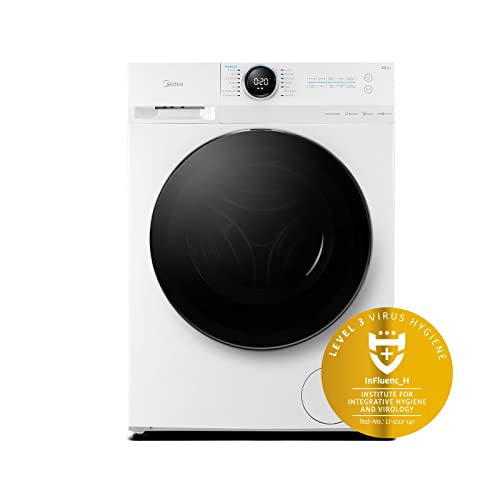The No. One Question That Everyone Working In 10kg Front Loader Needs …
페이지 정보
작성자 Napoleon 작성일24-03-04 10:19 조회3회 댓글0건관련링크
본문
Why Buy a 10kg Front Loader?
The front-loader of 10kg is ideal for large loads of laundry, with 13 wash programs that include handwash and plenty of space to accommodate large wash cycles. It's a sophisticated machine equipped with the latest features.
Front loaders generally take longer to wash, are not available in larger capacities and can often be prone to mildew and mould. However, they are much more efficient in terms of energy and water use than top loaders.
Energy
The major energy expense of a 10kg front loader is electricity to heat water to operating temperature and for running the motor. These costs can be offset by lower energy consumption when compared with top-loaders. This includes less power being used during the spin cycle and 10kg front loader agitation cycles and the use of less water. Some machines have a low-water wash option that requires significantly less water than the cotton cycle, saving on both energy and water usage.
In general, front-loading washers use less soap than top-loaders. The drum's tumbling action also reduces foamy suds, and decreases overflows, without affecting the cleaning process. The door seals as well as the bellows on top-loaders are more prone to wear. The mechanical agitator of a top-loader can also cause significant wear on clothing fabrics. It sways and drops clothes frequently, forcing them to rub against one another. This abrasion can be measured by the amount of fabric that is left on the lint screen, as lint is mostly composed of stray fibers that are detached from clothing while drying and washing machines 10kg capacity. Many top-loaders are designed to operate at slower speeds, and could also include the "freshening cycle" to clean the bellows or mechanical gears regularly.
Water
Top-loading washers require an impeller or agitator in order to force soap and water through the clothing, causing mechanical wear and abrasion. Front-loaders, on the other hand, use paddles to gently lift and 10Kg Front Loader drop clothes into a spinning drum during cleaning, thereby reducing wear. The rate of wear can be approximated by the amount of lint that is collected in dryer lint filters, which is largely composed of threads that are stray from clothing during drying and washing.
Since front-loaders require less water than top-loaders which means they are less prone to leakage. Front-loaders require a bellows or seal to stop water from spraying through the open door. These systems do not need to maintained as often as top-loaders.
Front-loaders are more energy efficient than top-loaders, as they can utilize hot or cold water and some even do so without an external heating source. This efficiency can lower operating costs for the same laundry load, especially in locations where energy, water and detergent are expensive.
The front-loader of 10kg is ideal for large loads of laundry, with 13 wash programs that include handwash and plenty of space to accommodate large wash cycles. It's a sophisticated machine equipped with the latest features.
Front loaders generally take longer to wash, are not available in larger capacities and can often be prone to mildew and mould. However, they are much more efficient in terms of energy and water use than top loaders.
Energy
The major energy expense of a 10kg front loader is electricity to heat water to operating temperature and for running the motor. These costs can be offset by lower energy consumption when compared with top-loaders. This includes less power being used during the spin cycle and 10kg front loader agitation cycles and the use of less water. Some machines have a low-water wash option that requires significantly less water than the cotton cycle, saving on both energy and water usage.
In general, front-loading washers use less soap than top-loaders. The drum's tumbling action also reduces foamy suds, and decreases overflows, without affecting the cleaning process. The door seals as well as the bellows on top-loaders are more prone to wear. The mechanical agitator of a top-loader can also cause significant wear on clothing fabrics. It sways and drops clothes frequently, forcing them to rub against one another. This abrasion can be measured by the amount of fabric that is left on the lint screen, as lint is mostly composed of stray fibers that are detached from clothing while drying and washing machines 10kg capacity. Many top-loaders are designed to operate at slower speeds, and could also include the "freshening cycle" to clean the bellows or mechanical gears regularly.
Water
Top-loading washers require an impeller or agitator in order to force soap and water through the clothing, causing mechanical wear and abrasion. Front-loaders, on the other hand, use paddles to gently lift and 10Kg Front Loader drop clothes into a spinning drum during cleaning, thereby reducing wear. The rate of wear can be approximated by the amount of lint that is collected in dryer lint filters, which is largely composed of threads that are stray from clothing during drying and washing.
Since front-loaders require less water than top-loaders which means they are less prone to leakage. Front-loaders require a bellows or seal to stop water from spraying through the open door. These systems do not need to maintained as often as top-loaders.
Front-loaders are more energy efficient than top-loaders, as they can utilize hot or cold water and some even do so without an external heating source. This efficiency can lower operating costs for the same laundry load, especially in locations where energy, water and detergent are expensive.

댓글목록
등록된 댓글이 없습니다.

